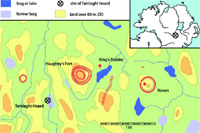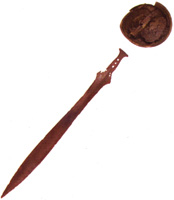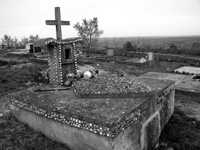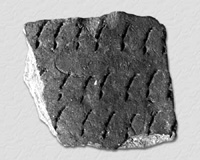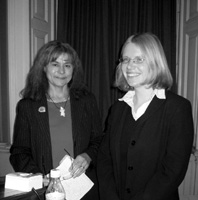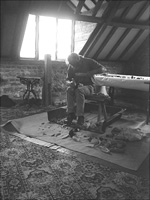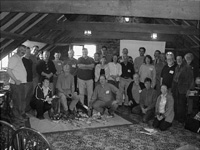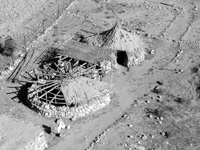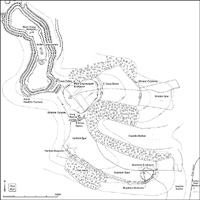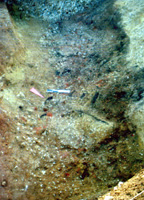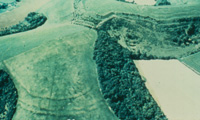|
|
|
|
A Unique 'Urnfield' Find from Ireland |
It is likely that many readers of PAST will have heard of Navan Fort
– an Iron Age ceremonial enclosure close to the town of Armagh,
in Northern Ireland. What is perhaps less well-known is that a kilometre
west of Navan is the trivallate hillfort of Haughey’s Fort, whose
excavation by Jim Mallory of Queen’s University showed it to have
been dug, and first (and mainly) used, at some time between 1150 and
1000 BC – a millennium before the heyday of Navan. Adjacent to
this hillfort is an artificial ritual pond – the King’s
Stables – which excavation by Chris Lynn proved to have been constructed
and used within roughly the same time-bracket as Haughey’s Fort. In February 2004, a detectorist searching a small dried-out marsh less than a kilometre from Haughey’s Fort unearthed a cache of bronze objects that he quickly (though not, unfortunately, before removing and washing them) reported to the Armagh County Museum. They were then sent to the Ulster Museum in Belfast for recording, conservation and study. The Environment and Heritage Service authorised a small excavation on the site of the discovery which was undertaken by archaeologists from the Centre for Archaeological Fieldwork at Queen’s University. The excavation gave useful information about the context of the hoard and uncovered a few small fragments and soil impressions that served to confirm the veracity of the finder’s report.
The objects consist of a bronze flange-hilted sword, now in several pieces; a small bronze bowl, virtually complete and only slightly damaged; a small bronze ring and many fragments of a decorated bronze cup. The objects had been carefully placed in the wet peat close to the original edge of the shallow bog. The complete vessel lay a few centimetres from the terminal of the sword, and in the line of its axis. The fragmentary vessel was wholly within the complete vessel. It is likely that tillage of the bog in the 19th century had damaged all the objects, although the act of removal had undoubtedly inflicted further damage. The objects and their context are still being conserved and studied, so the following must be regarded as very provisional conclusions. The butt of the flange-ilted sword has slightly convex shoulders and markedly concave ricassos. It does not fit easily into Eogan’s sword classification, having attributes of his classes 2 and 3. In default of an updated classification, I have ascribed to it a provisional class of its own – obviously called the Tamlaght type. I have been able to identify three or four very similar swords which can be placed within this class, all of which have come from the environs of Lough Neagh – suggesting a local workshop. Furthermore, class 2 and 3 swords, and the rare early imported swords (Hemigkofen), also cluster in this northern area. The local Late Bronze Age phase for the Tamlaght sword would be Eogan’s ‘Roscommon’ phase, from which there are only three other Irish hoards. This phase is contemporary with, and in many respects materially equivalent to, the English Wilburton phase, which on present evidence should date to between about 1150 and 1000 – the date bracket of the nearby Haughey’s Fort and King’s Stables. Many sword-mould fragments were found during the excavation of the latter, but they are not sufficiently well preserved to be classifiable.
The complete vessel is a small bowl with a slight everted rim, almost vertical neck and rounded, squat body. It is of the type called, in its Central European homeland, Fuchsstadt – though lacking the distinctive handle of most examples. Fuchsstadt bowls are found in graves and hoards over a wide area of Central Europe, but the variant to which the Tamlaght bowl belongs has two concentrations – around the upper Rhine and around the lower Elbe. These bowls are a distinctive component of Hallstatt A2, and into B1. The fragmentary vessel is decorated with rows of bosses, points and ribs – the decoration being clarified by a laser scan (by Kestrel3D) of impressions left in the peat in the bowl upon which the vessel had pressed when more complete. The vessel is a cup of Jenisovice (= Kirkendrup) type, found over a range slightly overlapping with that of the Fuchsstadt bowls, but concentrated in the lands of the middle Danube. These cups date to Hallstatt B1, which is the date of the few Continental finds containing both types. Until now neither type has, as far as I am aware, been found in the British Isles. Nor are direct imports (as opposed to influences) from Central Europe in periods A2/B1 particularly in evidence in Ireland. We should note, however, the roughly contemporary buckets of Danubian origin which are also concentrated in the north-east and one of which might have served as the container for the alcohol(?) for whose consumption the cup served as a drinking vessel. The Hallstatt B1 date for the importation of these vessels is precisely right for the date I have suggested above for the sword and for the date of Haughey’s Fort and the King’s Stables. There can be no doubt that the hillfort provides a context for the owner of the objects and for their deposition. Absolutely no traces of bone were found during the excavation, nor had the peat been disturbed, so we are unlikely to be dealing with a burial. The sword was not complete when buried – the organic handle and rivets were missing – and it seems likely that the handle, at least, of the cup was already detached as no rivets were found. Nevertheless the careful axial placing of the objects inclines me to the view that this must be interpreted as a ritual deposit. This hoard, with its unique association of Irish and Continental types, will, incidentally, become the first Northern Irish candidate for non-precious-metal- Treasure under the revised version of the Treasure Act. The work is ongoing and the conclusions tentatively reported here will, of course, be subject to refinement and, doubtless, correction before final publication. I am grateful to a number of people for their help, especially Sabine Gerloff, Brendan O’Connor, Katharina Becker, John O’Neill, Philip MacDonald and Joanne Marshall. R. Warner,
|
| THE
PREHISTORIC SOCIETY UK STUDY TOUR TO NORTHERN IRELAND |
| If I had to sum up my own personal feeling about this tour to Northern Ireland in just one word, then that word would be privileged. As a mature undergraduate student of archaeology, and as a new member of the Prehistoric Society, I felt privileged to have been selected for the student placement on the study tour. I feel privileged to have spent an enjoyable week in the company of such friendly members of the Prehistoric Society and the organisers of this tour, and privileged to have experienced Northern Ireland at its best. The tour began with a series of talks on the prehistory of Ireland, with Barrie Hartwell welcoming the members to Northern Ireland and introducing Peter Woodman who talked on the Mesolithic, Rick Schulting on the Neolithic, and Richard Warner on the Bronze and Iron Ages. The itinerary for the tour was organised by Sinéad McCartan, from the Department of Archaeology and Ethnography at the Ulster Museum, and Barrie Hartwell, from the School of Archaeology and Palaeoecology at Queen’s University Belfast. Although these two individuals have been thanked collectively by John Cruse, on behalf of the Society, and personally, by individual members, another thank you in print with an appreciation of the hard work that must have gone into the planning and organisation of this tour would not go amiss. Special thanks also go to Vincent McAllister who not only drove our luggage and packed lunches around the six counties of Northern Ireland, but who bravely, and very efficiently, delivered a talk at the very important Mount Sandel Mesolithic site in County Antrim whilst constantly looking over his shoulder for signs of Peter Woodman arriving. From the very beginning of the tour – a visit to the dual court tomb at Audleystown in County Down – the sites that we visited got better and better. In all, we visited some 40 sites, which included court tombs, portal tombs, passage tombs, wedge tombs, various cairns, stone circles, henge and timber enclosures, a prehistoric artificial ritual pond, earthworks, museums, and spectacular views of prehistoric landscapes. Some members also took the opportunity to visit the Giant’s Causeway and look at the stunning scenery of the Antrim coastline. The tour also took in some historic sites, such as St Patrick’s Cathedral and the public library in Armagh, the early Christian stone figures at White Island on Lower Lough Erne in County Fermanagh, and the ogham stone at Aghascrebagh in County Tyrone. A tour to any part of Ireland would not be complete without visiting one of its more enigmatic sites, and certainly the Linford earthworks are enigmatic – are they Neolithic, Bronze Age, multiperiod or could they be Roman watch towers? Receptions were held at the Ulster Museum and the Fermanagh County Museum, and refreshments were also provided at the Armagh County Museum. Many land owners had graciously given their consent for the Society to access their land to visit various sites, and many other people gave their time freely to meet the tour members at different locations and talk about them. Overall, the trip was extremely well organised, friendly and fascinating, and that is why I feel privileged to have been on this tour. David Greenwood,
|
The Sara Champion Memorial Lecture 2004 Forthcoming Society events include: The Holcombe Mirror: Iron Age Mirrors - the State of the Art,
Dr J. D. Hill (British Museum) The Beaker sequence: creating cultural history, Dr
Stuart Needham (British Museum) UK student study tour 2005: Lake District Stop Press – Extra Prehistoric Society Programme Item
Iron Age ‘Chariots’: New Sites – New Insights Megalithic Worlds
|
| KNAPPING
TECHNIQUES, MANUFACTURE AND REPLICATION RECONSIDERED: BREAKING STONES
FOR A WEEKEND? Practical demonstrations, site visits and lively discussions kept participants at a recent meeting of the Lithic Studies Society busy, as Clive Bond describes |
||
| The weekend after Easter, a dedicated band, with master craftsman John W. Lord, met at Knights Hill Hotel in King’s Lynn, Norfolk. Why? Answer - for a spot of ‘knapping’. I hasten to add, this is not a grand term for a siesta. No, it was to witness a suite of demonstrations, working flint into replica stone tools with discussion, debate and intrigue. This was a meeting of the Lithic Studies Society. Such people, me included, are often referred to as those odd ones, often solitary, whose closest friends consist of cores, flakes and tools, perhaps walking boots and, if lucky, a chance find of an earlier Neolithic flaked axe! Many in archaeology would think these poor people must get out more. The aims and objectives of the event were as follows:
This approach was adopted to enable a much needed ‘bridge’ to be developed between the theoretical aspects, ideas on manufacture and craft skills. Despite recent research carried out in order to better understand the lithic assemblages excavated from Palaeolithic sites at High Lodge, Suffolk, and Boxgrove, West Sussex, in Britain replication studies are not commonplace. Acceptance of this form of experimental archaeology in North America and continental Europe is more widespread. Exponents strove hard to bring experimental knapping into the mainstream. Work begun in the 1960s and 70s by François Bordes and acques Tixier, Don Crabtree, Errett Callahan and Bruce Bradley continues today. Those attending the meeting were from many walks of life: amateurs, professionals, academics. All were keen, knowledgeable and able to quiz the knapper. Often this created the need for improvisations in techniques to clarify aspects of technology such as platform preparation, rejuvenation and skill. As we passed from long blade to broad blade technology, across the late Upper Palaeolithic and early Mesolithic divide, John created perfect long blades. Effortlessly knapping, he progressed into broad blades, then microliths, all by changing the approach to platform preparation, maintenance and the execution of the blow, through direct and indirect percussion. John Lord succeeded in educating and enlightening us all. In the space of a few hours, John worked through c.500,000 years of prehistory! Indeed, in the last twenty minutes of the day, John knapped out a well-proportioned early Neolithic flaked axe at speed. This eloquent and determined craftsman had worked hard, and with sweat pouring from him and thousands of years of techniques behind him, had earned a well deserved pint. I suspect such experimental efforts, combined with the recent results of residue analysis on Beaker pottery, and considering the skill required to produce finely worked arrowheads – barbed-and-tanged arrowheads such as those recovered with the Amesbury archer – may lead us to revisit the ‘Beaker folk’ interpretation. The ‘Beaker folk’: people who were beer swilling, fond of feasting on pork and had a unique material culture – perhaps, this is not so ridiculous after all. What was the social context of knapping in the early Bronze Age? Feasting, drinking and lots of knapping, and why not?
John had procured high quality flint from Lynford pits, the location of the recent hominid handaxe site. Demonstration of techniques, the waste and the finished tools generated were remarkable: handaxes, Levallois to long blade, then broad/narrow blade production; microliths, burins, scrapers, an adze; flake production, a flaked axe and arrowhead. The master craftsman and educator shone through. The second day of the event commenced with a visit to a group of earlier Neolithic long barrows, two of the few that remain upstanding in this region. At this stage, we were joined by Helen Paterson from the Norfolk Monuments Management Project of the Norfolk Museums and Archaeology Service. Helen and I spoke at a range of sites on monument management, previous work and some fresh interpretations. A visit to a group of round barrows on Anmer Minque and Harpley Common followed. All locations had fields adjacent with dense lithic scatters. Samples of ithic material recovered by systematic survey were brought into the field to demonstrate and complete the link between lithic technology in the laboratory, experimental knapping and the actual locations where stone was worked. Despite the windy and wet weather, all were in good spirits, enthusiastic and appeared not too dazed by passing references in my presentation to walking the land, ceremonial processions, the ancestors or working stone as a symbolic act. Such things are a far cry from the often isolated studies of raw materials, technology and typology that dominate in lithic reporting. But behind the stone, as John had demonstrated so well, was always a person. Indeed, behind the person was a place to live, routines and tasks to complete, and places to bury the dead, customs to observe. Lithics were embedded in many human actions. The field visits completed the weekend: humanity transcended working stone; we explored the landscape context of stone tools and lithic scatters as social arenas. The weekend ended with lunch. The group vowed to meet again. With the high level of interest in the event, it was suggested that a discursive publication should be generated. Papers linking the themes Lithic Technology, Manufacture and Replication Studies Reconsidered are now coming forward, many by people at the event, others by specialists unable to attend. A volume will be published towards the end of 2004. Another meeting is planned for April 2005. So, perhaps we can awaken the ‘knapper’ in you? We should be pleased for you to come along to our next meeting and admit that you are in need of some help. Clive Jonathon Bond,
|
| TENTH
INTERNATIONAL CONFERENCE OF THE EUROPEAN ASSOCIATION OF SOUTHEAST ASIAN
ARCHAEOLOGISTS |
|
The 10th International Conference of the European Association of Southeast Asian Archaeologists was held at the British Museum from 14th to 17th September. The meeting was opened with speeches by Andrew Burnett, Deputy Director of the British Museum, and by H.R.H. Princess Maha Chakra Sirindorn of Thailand who also briefly spoke on her research, “Prasat Phanom Rung in the Light of the Inscriptions.” More than 170 people (from c. 17 countries) attended the conference with just over 115 papers and posters presented in 28 panels and poster sessions. Two concurrent sessions of panels ran throughout the four days, one focused on archaeology and the other emphasising art historical studies and heritage. The former included panels on: the Archaeology of Early Hunter-Gatherers; East Timor and the Expansion of the Austronesians; Aspects of Early Agriculture and Neolithic Cultures; and several regional panels (e.g. the Archaeology of Sarawak, Malaysia, the Archaeology of Thailand, of Indonesia, of the Philippines, of Burma, of Vietnam, and of Laos). The second set of panels included: Temple Arts: Architecture and Sculpture; Sculpture and Images; Text and Image in Buddhist Art; Iconography and Inscriptions; Technical Investigations in Southeast Asian Sculpture and Ornaments; Glazed Ceramics in Production and Trade; and Heritage Studies. Among the participants were 29 archaeologists from southeast and east Asia, including from Burma, Laos, Indonesia, Malaysia, the Philippines, Taiwan, Thailand and Vietnam. An award from the Prehistoric Society’s Conference Fund went towards funding the accommodation of several southeast Asian archaeologists. Overall, EurASEAA10 was able to support (to varying degrees) 14 southeast Asian scholars through the generosity of the Prehistoric Society in combination with generous funding from the British Academy Conference Fund, the British Academy Committee for Southeast Asian Studies, the British Council (Bangkok), the British Museum, the Department of Asia at the British Museum, the Charles Wallace Foundation (for Burma), the Siam Society (Bangkok), the Victoria and Albert Museum, the Victoria and Albert Museum’s Asian Art in London Fund, the Victoria and Albert Museum’s Anthony Gardner Memorial Fund, the Asia-Europe Fund, and a private donor. A special lecture, in honour of the late Professor Tong Enzheng, who had comparative interests in Chinese and Southeast Asian archaeology, was presented by Professor Charles Higham (University of Otago) on the second evening of the conference. The Victoria and Albert Museum hosted both the lecture and the following reception (where the wine flowed freely) in their Indian and Southeast Asian galleries. Post-conference tours were offered to the interpretive centre at Sutton Hoo, and to West Kennett longbarrow, Avebury and Stonehenge where English Heritage provided participants with special access. The conference successfully met its aims of: 1) disseminating and sharing results of recent archaeological, art historical, epigraphic and heritage research conducted in southeast Asia; and 2) facilitating interaction (often highly enthusiastic) among an international group of scholars working on topics important to understanding and explaining cultural change, diversity and continuity from the Palaeolithic through to the early historic periods in southeast Asia. The organisers plan a series of peerreviewed publications of revised conference papers. These volumes will serve to disseminate current research in southeast Asia to a larger audience, with the added aim of challenging the still-current view of the region as marginal to comparative understandings and explanations of cultural diversity and change. Elisabeth A. Bacus on
behalf of the EurASEAA10
|
|
RECONSTRUCTING THE HOUSES OF NEOLITHIC
JORDAN |
|
| The early Neolithic in Jordan and the Levant holds the key to the transition from hunter-gatherers to farmers, the beginnings of agriculture, the birth of religion, and the emergence of community life. One of the most important changes directly documented in the material evidence is the rapid development of architecture associated with increasing sedentism and community size.
My research includes building a series of experimental reconstructions of Neolithic structures at Beidha in southern Jordan. This research is designed to test interpretations based on primary data from the excavations of the Pre-Pottery Neolithic B (PPNB) village. The experiments are based on interim reports, unpublished site reports, and on-site observations. These experimental reconstructions will help inform the continuing debates concerning structural techniques, size and organisation, function of individual buildings, site location, organisation of interior space, and intersite variability over time. This spring saw the construction of a fourth experimental structure at Beidha. This small, 4m diameter, sub-circular stone-built structure abuts and shares walls with two structures built in 2003 to form a honey-combed agglomeration of circular buildings. This experiment addresses issues of village planning, community organisation and use of space. As a secondary objective, the use of experimental reconstructions at Beidha Neolithic Village in southern Jordan helps share with the public the intricacy of Neolithic life as discovered through excavations in Jordan. By increasing the public profile of Jordan’s Neolithic sites, and in particular Beidha, I also hope to inform the public and government on the benefits of preserving prehistoric sites. The Neolithic village at Beidha was excavated by a British archaeologist, Diana Kirkbride, in the 1960s and 1980s but at the time no steps were taken to conserve or present the site. Left exposed for over 40 years, it is now collapsing. Future work on the site includes ongoing monitoring of the four structures and the conflagration of one circular structure. Samantha Dennis, University of Edinburgh Acknowledgements
|
|
| Canon William Greenwell and his contemporaries: The history of British archaeology in the nineteenth and early twentieth centuries The Greenwell Conference will be held at the Department of Archaeology, University of Durham, April 16-17, 2005. Papers are invited relating to the life and work of William Greenwell, antiquarian, archaeologist, collector, historian, numismatist, fisherman . . . polymath. Papers on the broader context of Greenwell’s archaeological researches are particularly encouraged. The conference aims to give a flavour of the rich and varied research environment of Greenwell’s time. Abstracts should be no more than 300 words and should be submitted by November 30, 2004. Students £6.00. Other delegates £10.00. Contact Dr. Anne O’Connor, Greenwell Organising Committee: Department of Archaeology, University of Durham, South Road, Durham DH1 3LE, UK Email: canon.greenwell@durham.ac.uk. Website is available at: http://www.dur.ac.uk/canon.greenwell The Archaeology of Infancy and Childhood: call for papers
and poster presentations
|
|
| Hambledon Hill, in Dorset, persists in prehistorians’ consciousness because of roles which were flagged up in the 1970s and 1980s, when it emerged as a site where human corpses underwent excarnation and as the scene of Neolithic warfare and defensive architecture on a scale previously unthought of in Britain. A programme of post-excavation analysis funded by English Heritage in the 1990s has expanded understanding of these functions, and has redefined numerous other aspects of the site’s use.
The hill itself stands on the boundary of the Wessex Chalk and the very different landscape — both topographically and culturally — of the south-west. It is an island cut off from the mass of the Chalk by rivers and is a striking landform, with spurs radiating from a central dome. The whole hill (approximately 1.5 km long) was used and modified in the fourth millennium BC, although the Iron Age hillfort subsequently built on the northern spur obscures the Neolithic earthworks there. The demonstrably fourth millennium earthworks comprise two long barrows, two causewayed enclosures and at least nine outworks and cross-dykes. Its role as an excarnation site has come more sharply into focus from Jacqueline McKinley’s analysis of the human remains. Some have been gnawed, occasionally when still articulated, by dogs or rodents, and there is a scarcity of the smaller and more readily degraded elements, such as the bones of the hand and foot and the articular ends of long bones. These features had already been noted. What is new is that some human remains, again including articulated ones, carry fine cut-marks, made with flint tools during the deliberate removal of flesh from the bones by the living. This was carried out in a quite different way from the butchery practiced on the animal bone. Excarnation could be an active process as well as a passive one. Many of the completely disarticulated human bones could, of course, have been brought to the hill from elsewhere. This is particularly likely of crania, which tend to be more weathered than other parts of the anatomy.
The defensive architecture of the hill, and the conflict which it anticipated, have acquired time-depth, thanks to a programme of radiocarbon dating undertaken by Alex Bayliss of English Heritage. In the 1980s a colleague viewing the mass of Neolithic earthworks on Hambledon for the first time exclaimed ‘This would be Early State the other side of the Atlantic!’, on the grounds that only a political unit of that scale could provide the organisational, human, and material resources to build a complex of this size. It has now become clear that the complex grew progressively and that construction, together with the recutting and remodelling of existing earthworks, was piecemeal, spread between 3680 and 3320 cal BC. At any one time, the complex would have consisted of weathered earthworks, some of them recut or refurbished, and newly-built ones. The course of this process reflects changing preoccupations: once the main enclosure on the central dome of the hill was built, other elements were added to the east side of the hill, facing towards Cranborne Chase and the Wessex Chalk. The final, and largest, episode of construction, however, resulted in the erection of a timber-laced chalk and earth wall along the west side of the central dome and the north spur, presenting a monumental barrier to the lower-lying lands of the Vale of Blackmoor to the west. Within that span of three to four centuries, even the largest constructional undertakings could have been accomplished by a workforce of about 100 in about six months. The superficially vast collection of artefacts and food remains can, if inflated to allow for unexcavated areas and then spread across the lifespan of the complex, be reduced to the equivalent of a couple or three well-stuffed pits a year. Yet, Tony Legge has shown that the butchered remains of more than one cow were sometimes deposited in a single episode of ditch-filling — and just one cow would have provided some 300 kg of meat, offal and fat. Consumption on this scale implies, like the estimated size of the labour force which built each part of the complex, that large numbers of people came to the site occasionally. This accords with the predominantly wooded conditions evidenced by the snail shells from the Neolithic pits and ditches — circumstances which would scarcely have obtained if people and their animals had been on the hill habitually. Short stays are also suggested by a preponderance of small pots, suitable for eating and drinking, rather than large ones suitable for storage.
Some of the earthworks were defensive, but episodes of conflict were, like construction, spread over time. Before the middle of the fourth millennium BC, a timber-laced outwork on the Shroton spur of the hill was burnt down along at least 140 m of its length. This was followed by the firing of the more massive inner Stepleton outwork to the south, which was burnt down along a length of 160 m. It was a while after this that two young men, both killed by arrowshot, possibly at the same time, were buried in separate ditches on the Stepleton spur. Conflict, in other words, seems to have been as episodic as the construction and use of the site. The periodic gathering of otherwise scattered populations could provide opportunities for hostilities on a scale otherwise impossible, and could prompt the construction of defences. The scale of the Hambledon complex and, by implication, its importance and the numbers of people which it could accommodate, could have made its users particularly conspicuous and vulnerable. The ecotonal — even frontier — location of the site may have made it more of a theatre for conflict than many other enclosures. These were, however, brief interludes in its long life. When the complex went out of use, however, it was not the result of any catastrophe, but of changing beliefs and practices. At about the same time as the last Neolithic earthworks were being built on the hill, the Dorset cursus was under construction in Cranborne Chase to the east, at a date estimated as 3360–3030 cal BC (Barclay and Bayliss 1999, 22–23). The cursus is, like Hambledon, the largest known monument of its kind in Britain, but it expressed a completely different approach to ceremony and gathering, just as its location firmly in the chalkland of Cranborne Chase reflected a new local focus, away from the ‘frontier’ location of Hambledon. Roger Mercer and Frances Healy References
|
|||
| |
The Prehistoric Society Home Page |
